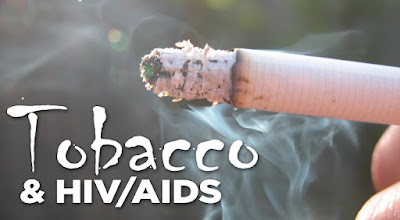By: Ranier Simons, ADAP Blog Guest Contributor
Smoking-related diseases and death remain some of the most preventable health issues today. While the prevalence of smoking habits has been continuously declining, in 2021, 11.5% (28.3 million) of the general U.S. population aged 18 or older still currently smoked cigarettes.[1] The designation of “currently smoking” is defined as having smoked 100 or more cigarettes in a lifetime combined with present daily use or every few days. Data shows that the prevalence of cigarette smoking among people living with HIV (PLWH) is significantly higher than the general population, estimated to be between 34-47%.[2] This is an alarming trend because smoking reduces the life expectancy of PLWH who smoke compared to those that do not.[2] Additionally, 94% of lung cancers among PLWH who smoke could possibly be prevented by smoking cessation.[2]
.png) |
| Photo Source: AIDSmap |
There are several medical issues, other than lung cancer, among PLWH that are linked to smoking: bacterial pneumonia, heart disease, chronic obstructive pulmonary disease (COPD), and other non-AIDS-defining cancers.[3] Research shows that these same issues are also comorbidities that take the lives of PLWH about ten years sooner than the HIV-negative population.[5] Data also shows that smoking PLWH who have achieved viral suppression through consistent antiretroviral treatment are more likely to die from lung cancer than traditional AIDS-related causes.[4] Most importantly, HIV is an independent risk factor for smoking-related cancers.[3] This means that being HIV positive increases the risk of developing smoking-related cancer much higher than the odds expected from smoking alone.
A recent study conducted at Florida International University aims to explore why HIV infection exacerbates the adverse health outcomes of conditions like COPD in PLWH who smoke.[5] A smoking robot takes the smoke from standardized research cigarettes and exposes HIV cells to the smoke. The specific cells are cells from the respiratory tract lining in HIV-associated COPD. The research aims to discover what encourages lung inflammation in PLWH, hoping to create treatments that reverse the damage to restore function or at least prevent further deterioration.[5]
Given the importance of encouraging smoking cessation among PLWH, it is crucial also to understand the characteristics of the populations of PLWH who smoke. To examine the comorbidities and characteristics of PLWH who smoke, a group of researchers investigated data from an ongoing study of PLWH in Washington, DC, called the D.C. Cohort Longitudinal HIV study. The DC Cohort study participants are PLWH who get their care from a group of fifteen medical care sites in Washington, DC. Clinical data is collected to help improve the treatment and outcomes of PLWH in the area. Researchers found that half of the 8,600 subjects are smokers.
Examination of the data revealed intersections of socioeconomics, gender, race, and comorbidities.[7] Almost half of the smoking subjects had a mental health disorder. Four percent suffered from cardiovascular disease, eight percent had cancer, and two percent had pulmonary disease. Those with mental health challenges were more likely to be female, white, and older; likely to be uninsured or have public health insurance; and have housing instability. Those with cardiovascular disease, cancer, or pulmonary disease were more likely to be older, female, non-Hispanic Black race/ethnicity, or with housing instability. Regarding other characteristics, about 75% of the smoking subjects were unemployed, 15% had private insurance, and 57% were younger than age 50.
 |
| Photo Source: Breathe DC |
These data points show how the population of PLWH who smoke is not a monolith in any way. Therefore, efforts to encourage smoking cessation must specifically meet those affected on the level of where they are in their lives. Success requires targeting particular subgroups of marginalized and high-risk individuals. Continued medical research into the specificity of how smoking affects PLWH differently is paramount as well. Research has even shown that PLWH metabolize nicotine faster than HIV-negative smokers, thus making it harder for them to stop smoking.
One popular way suggested by some as a means to reduce the harm of smoking tobacco while still helping those with nicotine addictions is vaping, also known as e-cigarettes.[6] However, research suggests chemicals in e-cigarettes harm the heart and lungs. E-cigarettes that contain nicotine have been associated with elevated blood pressure and heart rate. The vaping products that do not contain nicotine have also been shown to be harmful due to their flavoring ingredients and other unknown proprietary chemicals. Moreover, e-cigarettes have been correlated with developing ailments like COPD in the same manner as combustible cigarette smoking.
Smoking cessation is another challenge, like substance abuse disorder, that needs to be normalized as part of the whole-person healthcare treatment of PLWH.
 |
| Photo Source: DC Tobacco Free Coalition |
[1] CDC. (2023, May 4). Burden of cigarette use in the U.S. Retrieved from https://www.cdc.gov/tobacco/campaign/tips/resources/data/cigarette-smoking-in-united-states.html
[2] NIH. (2023, June 22). Tobacco and HIV. Retrieved from https://cancercontrol.cancer.gov/brp/tcrb/tobacco-hiv#:~:text=Over%201.2%20million%20people%20in,34%2D47%25%20smoke%20cigarettes
[3] U.S. Department of Health and Human Services. (2022, December 7). Smoking and HIV. Retrieved from https://www.hiv.gov/hiv-basics/staying-in-hiv-care/other-related-health-issues/smoking/
[4] Reddy KP, Kong CY, Hyle EP, et al. Lung Cancer Mortality Associated With Smoking and Smoking Cessation Among People Living With HIV in the United States. JAMA Intern Med. 2017;177(11):1613–1621. doi:10.1001/jamainternmed.2017.4349
[5] Varela, I. (2023, July 17).Robot helps researcher study effects of smoking on people with HIV. Retrieved fromhttps://news.fiu.edu/2023/robot-helps-researcher-study-effects-of-smoking-on-people-with-hiv
[6] Sforza, L. (2023, July 18). Vaping harms heart and lungs: American Heart Association. Retrieved from https://thehill.com/policy/healthcare/4103481-vaping-harms-heart-and-lungs-american-heart-association/
[7] Wolters Kluwer Health. (2023, July 14). Gender, race and socioeconomic status are associated with comorbidity in people with HIV who smoke. Retrieved from https://medicalxpress.com/news/2023-07-gender-socioeconomic-status-comorbidity-people.html
Disclaimer: Guest blogs do not necessarily reflect the views of the ADAP Advocacy Association, but rather they provide a neutral platform whereby the author serves to promote open, honest discussion about public health-related issues and updates.

.png)





